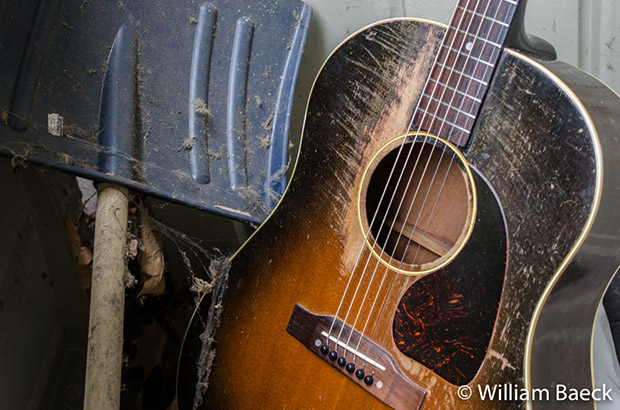The GAS Man: Should You Buy That Vintage Wreck? Part 1

Buying a beat-up guitar can net you a bargain, but you need to know what you’re letting yourself into. Otherwise, you might be the one left feeling beat up in the end.
In this first of a three-part series, I’ll talk about the experience of buying a worn and battered vintage guitar and why you might ever consider it.
Part two will list things to think about before buying a vintage guitar in need of major repairs. In part three, I’ll give you some questions to ask your guitar repairman if you decide to go this route.
The short-attention-span version: Don’t buy a structurally damaged guitar unless you know what you’re doing. It usually doesn’t make financial sense unless the guitar is high-end, vintage or you’re getting it dirt cheap. If you do know what you’re doing, you can get yourself a guitar with the sound and playability, if not the condition, of an all-original example for a lot less money.
I’ve been the beneficiary and victim of buying this kind of guitar. But let’s concentrate on the positive here with a story of how buying beat can work out.
Some years back I spotted a Craigslist ad I couldn’t ignore: an old Gibson J-45 for $350. The seller was up front about the condition. The next day I drove over to check it out in person. The good news: it was indeed old—from 1950, with the tapered headstock, correct logo and serial number, and reverse bridge. Best of all, it sounded amazing, with that big Barry White bass E. The provenance was good too, as the seller was the son of the man who’d bought it new in 1950.
- But then there was the bad news and a number of—ahem—issues. All of them were traceable to the fact that the guitar had been on loan to a friend in the son’s Industrial Goth band. For years the friend had been doing his best Pete Townshend impression on this valuable old Gibson.
- It had been literally beaten—showing a fair amount of left-in-the-yard-chained-to-a-tree kind of wear.
The bottom strap button was gone, replaced with what appeared to be a small aluminum tent peg. A chunk of wood had been broken off the heel, probably for kindling in an Industrial Goth rite. There was a pair of small side cracks and a substantial gouge on the top that tore through to the brace underneath. The finish around the soundhole was worn down to the bare wood, due to aggressive strumming or an Industrial Goth ferret.
Get The Pick Newsletter
All the latest guitar news, interviews, lessons, reviews, deals and more, direct to your inbox!
Most worrying of all was that the headstock and bridge had apparently become fond of each other and were soon going to meet face to face. This, in turn, caused the strings to rise so far above the fretboard that only a high-wire artist could play beyond the fifth fret.
Of course, the guitar needed a neck reset, something common on old Gibsons. Unfortunately, what our guitar hero had done was cheap out and take some monumentally poor advice. Instead of doing a proper reset, the repairman—or to be technically accurate, idiot—had instead removed the original bridge, which had been in fine condition and in the correct location. Then in a transcendentally dumbass move, he replaced it with a reproduction bridge moved back to compensate for the poor intonation caused by the tilting neck. In simple terms, he tried to fix what was wrong by making it worse.
The result? A non-original bridge in the wrong location, the same high action, but with chords on the first few frets slightly more in tune than before.
I say all this to give you an idea of what I was starting with, as it’s pretty typical of a beat vintage guitar with potential.
I figured I could have it repaired for less than $1,000, so I bought the guitar and eventually saved up the money to get it fixed correctly. A few months ago I got estimates from four good local luthiers and chose the one I felt most comfortable with to take on the project.
After letting him look it over thoroughly, he and I agreed the best idea was to have all the functional issues dealt with, but not to spend any extra to have it refinished or prettied up to look like new. My total outlay ended up being $350 for the guitar and $700 for the repair work. For that price, I got a very playable, structurally sound, though worn-looking 1950 J-45, with another half-century of life left in it.
All in all, it was a positive experience and a cheap way to end up with a great vintage guitar.
In part two, I’ll go over a few things to think about before buying a vintage wreck.
William Baeck is a writer, photographer and hack guitarist living in London. You can check out his webpage at williambaeck.com and reach him on Facebook and Twitter.
"Upgrading from your entry-level acoustic opens the door to an entirely new world of tonewoods, body shapes, and brands": 6 signs it's time to upgrade from your first acoustic guitar
"I'm past my prime": 5 common excuses for not learning the guitar – and 5 body and mind-boosting reasons you should









